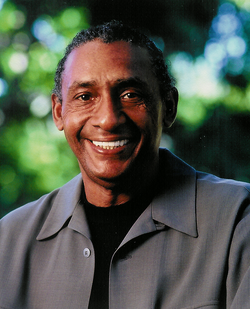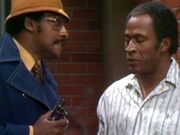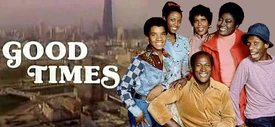| ||||
|---|---|---|---|---|
 | ||||
| Personal Information | ||||
| Birthname: | Ernest Eugene Barnes, Jr. | |||
| Born: | July 15, 1938 | |||
| Birthplace: | Durham, North Carolina, U.S. | |||
| Deathplace: | Los Angeles, California, U.S. (blood cancer) | |||
| Career information | ||||
| Occupation/ Career: |
American artist, former athlete, and author | |||
| Years active: | 1959-2009, his death | |||
| Series involved with: | Good Times | |||
| Job on series | painted artwork used on the series appeared as Armed hoodlum in "The Houseguest" (Season 2) Appeared as one of Sweet Daddy Williams's hoods in "Sweet Daddy Williams" (Season 3) | |||
Ernie Barnes was a painter/visual artist who was well known for his unique style of etonation and movement. Ernie, who was also a former professional football player, also acted as well; he appeared as one of the hoods of "Marion "Sweet Daddy" Williams in the episode "Sweet Daddy Williams" in Season 3 of Good Times. He also appeared as an armed hoodlum in the Season 2 episode "The Houseguest". Ernie painted all of the artwork which was used in the series, which included all of the artwork of J.J. Evans. His now famous painting "Sugar Shack", was used as the opening screenshot of Good Times in Seasons 4 and 5.

Evans' family painting used in the series' opening in Seasons 1-3.
About Ernie[]
Born during the Jim Crow era in “the bottom” community of Durham, North Carolina. His father, Ernest E. Barnes, Sr. (1900–1966) worked as a shipping clerk for Liggett Myers Tobacco Company. His mother, Fannie Mae Gee. 1905–2004) oversaw the household staff for prominent Durham attorney and Board of Education member Frank L. Fuller, Jr.
On days when Fannie allowed “June” (Barnes’ nickname to his family and childhood friends) to accompany her to work, Barnes had the opportunity to peruse the art books and listen to the classical music in Fuller’s study. The young Ernest was intrigued and captivated by the works of master artists. By the time Barnes entered the first grade, he was familiar with the works of such masters as Toulouse-Lautrec, Delacroix, Rubens, and Michelangelo. When he entered junior high, he could appreciate, as well as decode, many of the cherished masterpieces within the walls of mainstream museums – although it would be a half dozen more years before he was allowed entrance because of his race.

Ernie as one of Sweet Daddy Williams's henchmen in "Sweet Daddy Williams" in Season 3.

Ernie Barnes as armed hood looking for Ernie Harris, an old accquaintance of James, who is indebted to the mobster he works for in "The Houseguest" in Season 2.
A self-described chubby and unathletic child, Barnes was taunted and bullied by classmates. He continually sought refuge in his sketchbooks, hiding in the less-traveled parts of campus away from the other students. One day in a quiet area, Ernest was found drawing in a notebook by the masonry teacher, Tommy Tucker, who was also the weightlifting coach and a former athlete. Tucker was intrigued with Barnes' drawings so he asked the aspiring artist about his grades and goals. Tucker shared his own experience of how bodybuilding improved his strength and outlook on life. That one encounter would begin Barnes' discipline and dedication that would permeate his life. In his senior year at Hillside High School, Barnes became the captain of the football team and state champion in the shot put and discus throw.
Ernie graduated from Hillside High School in 1956 with 26 athletic scholarship offers. Because of segregation, he was prevented from considering nearby Duke or the University of North Carolina. His mother promised him a car if he lived at home, so he attended the all-Black North Carolina College (now North Carolina Central University) which was then-located across the street from his high school. At NCC, he majored in art on a full athletic scholarship. His track coach was the famed Dr. Leroy T. Walker.[1] Barnes played the football positions of tackle and center at NCC, and was selected to the All-Conference team.
In December 1959 Barnes was drafted in the 10th round by the then-World Champion Baltimore Colts. He was originally selected in the 8th-round by the Washington Redskins, who renounced the pick minutes after discovering he was a Negro.
He would play with five teams during his career, the Colts, the AFL's N.Y. Titans (now known as the New York Jets), the then-Los Angeles Chargers (they would move to San Diego in 1962, the yaar after he arrived there), and the Denver Broncos, as well as the Saskatchwen Roughriders of the CFL.

"Sugar Shack" painting used in the opening of "Good Times" in Seasons 4 and 5, as well as for the cover of the 1976 Marvin Gaye LP "I Want You".
"Sugar Shack" painting[]
Ernie also created the painting Sugar Shack in the early 1970s. It gained international exposure when it was used on the Good Times television series and on the 1976 Marvin Gaye album I Want You.
According to Barnes, he created the original version of Sugar Shack after reflecting upon his childhood, during which he was not "able to go to a dance."[1] In a 2008 interview, Barnes said, "Sugar Shack is a recall of a childhood experience. It was the first time my innocence met with the sins of dance. The painting transmits rhythm so the experience is re-created in the person viewing it. To show that African-Americans utilize rhythm as a way of resolving physical tension.”[2] The Sugar Shack has been known to art critics for embodying the style of art composition known as "Black Romantic," which, according to Natalie Hopkinson of The Washington Post, is the "visual-art equivalent of the Chitlin' circuit."[3]
Music album covers[]
Barnes’ other album cover work appears on the following album covers:
- Disco on self-titled 1978 Faith, Hope & Charity
- Donald Byrd and 125th Street, NYC on self-titled 1979 album
- Late Night DJ on Curtis Mayfield’s 1980 Something to Believe In
- The Maestro on The Crusaders' 1984 Ghetto Blaster
- Head Over Heels on The Crusaders’ 1986 The Good and Bad Times
- In Rapture on B.B. King’s 2000 Making Love is Good For You
References[]
- ↑ Oakland Tribune - Top Black Painter Exhibits in Oakland - August 14, 2002. oaklandtribune.com. Retrieved on October 26, 2010
- ↑ Ernie Barnes Interview ( 英語 ). Soul Museum: Ernie Barnes. Retrieved on October 26, 2010.
- ↑ Neal, Mark Anthony. Review: I Want You. PopMatters. Retrieved on October 26, 2010.
External links[]
- Ernie Barnes's official website
- Ernie Barnes at the Internet Movie Database
- Ernie Barnes article at Wikipedia
